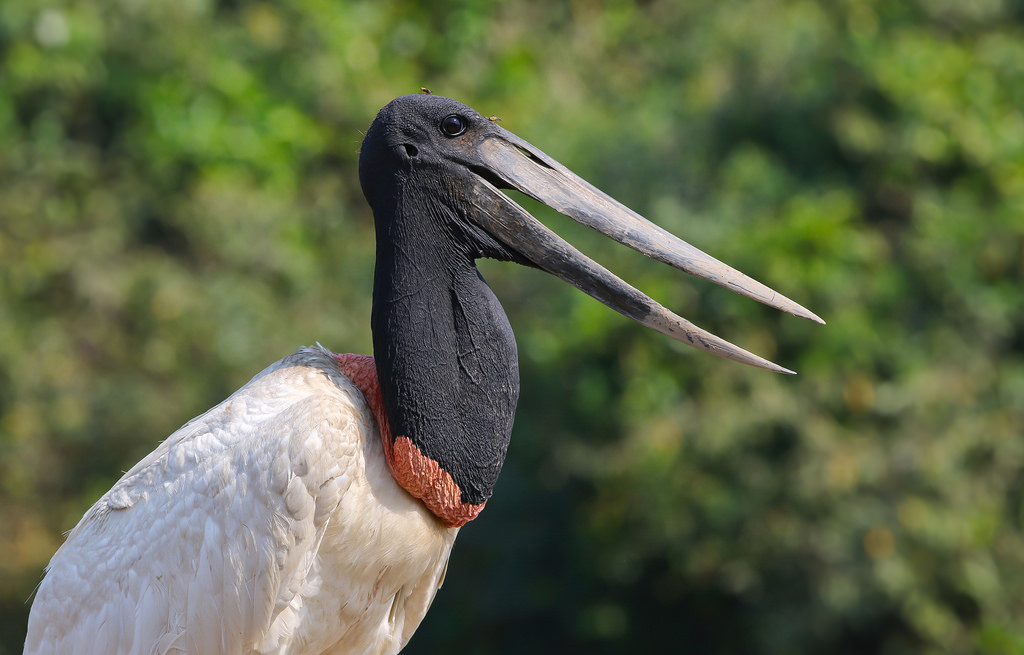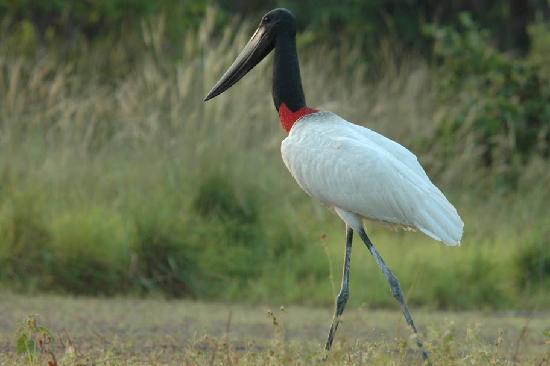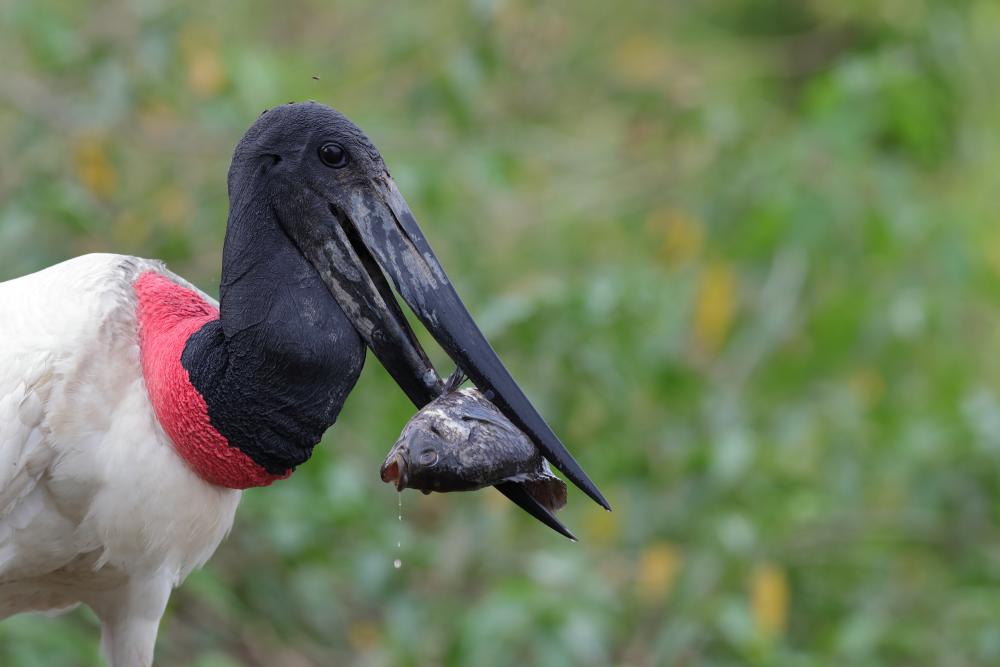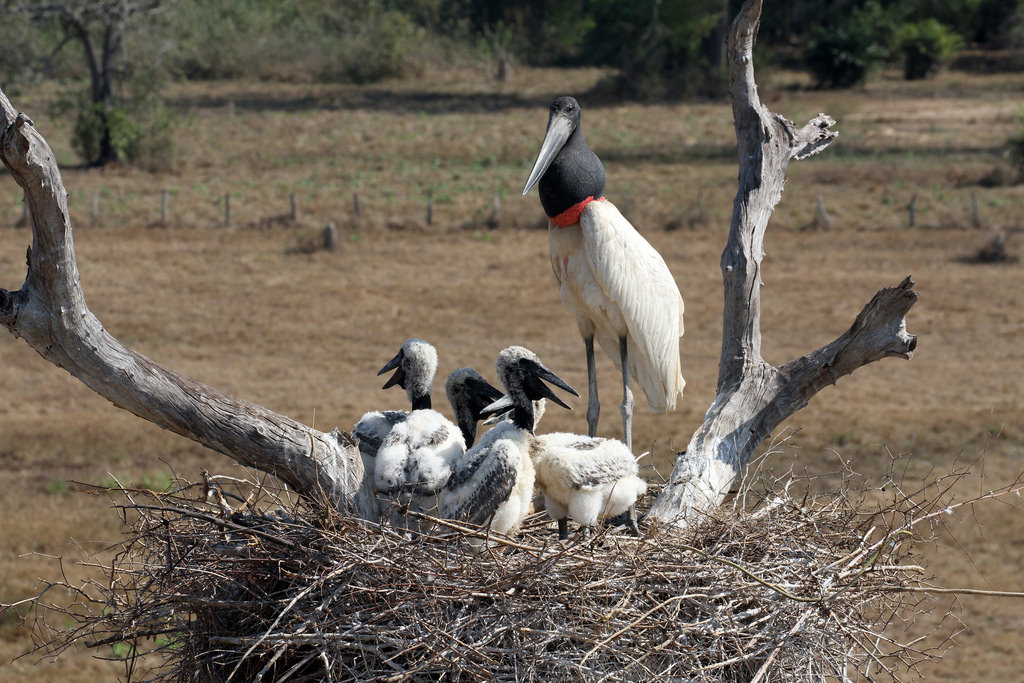Deep in the rainforest where so many birds can be found, you look up and see the majestic jabiru stork swooping down from above. Being the tallest flying bird found in South America and Central America, it captivates you with its large wingspan and beautiful colors. The jabiru stork is a powerful but graceful flier found in Guyana – home of mesmerizing birdlife.
The jabiru storks can be seen on sandbanks of rivers and in swamps of the Iwokrama Rainforest and North Rupununi. They are a common sight in flooded savannah lands in the wet season, picking their way with their long legs looking for food.

Jsbiru Stork | https://www.flickr.com/photos/ajmguerra/29468195102/
Features of the Jabiru Stork
- Beak: The beak is black and broad, slightly upturned, ending in a sharp point. It measures 25–35 cm (9.8–13.8 in) in length.
- Head: The head and upper neck are featherless and black. There is also a featherless red stretchable pouch at the base.
- Tail and Tarsus: The tail measures 20–25 cm (7.9–9.8 in) and the tarsus measures 28.5–39 cm (11.2–15.4 in) long.
- Wing: For the continent, the jabiru has the second largest wingspan, after the Andean condor (that is, excluding the great albatross occasionally found off the coast of southern South America). The adult jabiru’s wingspan is 120–140 cm (47–55 in) long, 2.3–2.8 m (7.5–9.2 ft.) across the wings, and can weigh 4.3–9 kg (9.5–19.8 lbs.).
- Weight: The males are about 25% larger than the females, they are similar in appearance but when the male and female stand together you notice that the male is larger. Males weigh an average of 6.89 kg (15.2 lbs.) whereas females weigh an average of 5.22 kg (11.5 lbs.). Large males may stand as tall as 1.53 m (5.0 ft.).

Jabiru Stork @ Karanambu | https://www.tripadvisor.co.uk
Scientific Classification of the Jabiru Stork
Jabiru Stork – Jabiru mycteria [Scientific name]
- Kingdom: Animalia
- Phylum: Chordata
- Class: Aves
- Order: Ciconiiformes
- Family: Ciconiidae
- Genus: Jabiru
- Species: J. mycteria
Diet and Feeding Manner of the Jabiru Stork
The jabiru lives in large groups near rivers and ponds, and eats prodigious quantities of fish, molluscs, and amphibians. It will occasionally eat reptiles, bird eggs and small mammals. It will even eat fresh carrion and dead fish, such as those that die during dry spells, and thus help maintain the quality of isolated bodies of water. They feed in flocks and usually forage by wading in shallow water. Jabirus detect prey more through tactile sensation than vision. They feed by holding their open bill at a 45 degree angle to the water. When prey is contacted, the storks close their bill, draw it out of the water, and throw their head back to swallow. It is an opportunistic feeder.

Eating a fish | https://www.hbw.com/ibc/species/jabiru-jabiru-mycteria
Did You Know?
When the jabiru eats the dead animals that they find in the water, they are actually helping to keep the water clean.
Reproduction of the Jabiru Stork
The parents take turns incubating the clutch of two to five white eggs and are known to be more territorial than usual against other jabirus during the brooding period. Raccoons and other storks (including their own species) are occasional predators of jabiru eggs, but most nest predators appear to avoid these huge-billed birds. There are no known predators of healthy adult jabirus. Although the young fledge around 110 days old, they often spend around another 3 months in the care of their parents. The lifespan average is 36 years.
The Jabiru’s Nest
The nest of sticks is built by both parents around August–September (in the Southern Hemisphere) on tall trees, and enlarged at each succeeding season growing to several meters in diameter. Nests are often deeper than they are wide, they can be up to 1 m (3.3 ft.) wide and 1.8 m (5.9 ft.) deep. Half a dozen nests may be built in close proximity, sometimes among nests of herons and other birds.

Jabiru Nest | https://www.flickr.com/photos/arctic_al/21063249054
Tip: The name of the Jaribu comes from the Tupi-Guarani language and means “swollen neck”.
Watch This
Jabirus In Guyana
Some were privileged to see this beautiful bird at the airstrip at Karanambu, early in the morning one or two were found stalking through the grass in the fog when the plane arose. Others are seen building large nests of sticks in emergent trees on river banks or near wetlands, usually in Silk Cotton (Ceiba) trees and when they often return to old nests year after year. These majestic and powerful birds are a gift found among the many birds in the land of Guyana. Their features are unique and they have an amazing feeding manner. Yes, it is wonderful to see the tallest flying bird in South and Central America.
Article References:
- https://www.stabroeknews.com/2011/features/01/09/in-the-rainforest-jabiru-stork/
- https://en.wikipedia.org/wiki/Jabiru
- http://birdaz.com/blog/2007/12/31/guyana-storks/







1 Comment
Pingback: 30 Amazing Animals That Start With J - Teaching Expertise